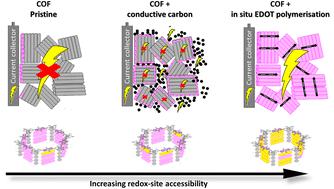当前位置:
X-MOL 学术
›
J. Mater. Chem. A
›
论文详情
Our official English website, www.x-mol.net, welcomes your
feedback! (Note: you will need to create a separate account there.)
Redox-site accessibility of composites containing a 2D redox-active covalent organic framework: from optimization to application
Journal of Materials Chemistry A ( IF 10.7 ) Pub Date : 2023-04-13 , DOI: 10.1039/d3ta00422h Tyran Günther 1 , Kouki Oka 2 , Sandra Olsson 1 , Michelle Åhlén 1 , Norimitsu Tohnai 2 , Rikard Emanuelsson 3
Journal of Materials Chemistry A ( IF 10.7 ) Pub Date : 2023-04-13 , DOI: 10.1039/d3ta00422h Tyran Günther 1 , Kouki Oka 2 , Sandra Olsson 1 , Michelle Åhlén 1 , Norimitsu Tohnai 2 , Rikard Emanuelsson 3
Affiliation

|
Redox-active covalent organic frameworks (RACOFs) can be employed in various functional materials and enesrgy applications. A crucial performance or efficiency indicator is the percentage of redox centres that can be utilised. Herein, the term redox-site accessibility (RSA) is defined and shown to be an effective metric for developing and optimising a 2D RACOF (viz., TpOMe-DAQ made from 2,4,6-trimethoxy-1,3,5-benzenetricarbaldehyde [TpOMe] and 2,6-diaminoanthraquinone [DAQ]) as an anode material for potential organic-battery applications. Pristine TpOMe-DAQ utilises only 0.76% of its redox sites, necessitating the use of conductivity-enhancement strategies such as blending it with different conductive carbons, or performing in situ polymerisation with EDOT (3,4-ethylenedioxythiophene) to form a conductive polymer. While conductive carbon-RACOF composites showed a modest RSA improvement of 4.0%, conductive polymer-RACOF composites boosted the redox-site usage (RSA) to 90% at low mass loadings. The material and electrochemical characteristics of the conductive polymer-RACOF composite containing more-than-necessary conductive polymer showed a reduced surface area but almost identical electrochemical behaviour, compared to the optimal ratio. The high RSA of the optimally loaded composite was replicated in a RACOF-air battery with over 90% active redox sites. We believe that the reported approach and methods, which can be employed on a milligram scale, could serve as a general guide for the electrification and characterisation of RACOFs, as well as for other redox-active porous polymers.
中文翻译:

包含二维氧化还原活性共价有机框架的复合材料的氧化还原位点可及性:从优化到应用
具有氧化还原活性的共价有机框架 (RACOF) 可用于各种功能材料和能源应用。一个关键的性能或效率指标是可以利用的氧化还原中心的百分比。在此,术语氧化还原位点可访问性 (RSA) 被定义并显示为开发和优化 2D RACOF 的有效指标(即,由2,4,6-trimethoxy-1,3,5- 制成的 TpOMe-DAQ苯三甲醛 [TpOMe] 和 2,6-二氨基蒽醌 [DAQ])作为潜在有机电池应用的阳极材料。Pristine TpOMe-DAQ 仅利用其氧化还原位点的 0.76%,因此需要使用电导率增强策略,例如将其与不同的导电碳混合,或原位执行与 EDOT(3,4-乙烯二氧噻吩)聚合形成导电聚合物。虽然导电碳-RACOF 复合材料显示出 4.0% 的适度 RSA 改善,但导电聚合物-RACOF 复合材料在低质量负载下将氧化还原位点使用率 (RSA) 提高到 90%。与最佳比例相比,含有过多导电聚合物的导电聚合物-RACOF 复合材料的材料和电化学特性显示表面积减少,但电化学行为几乎相同。在具有超过 90% 活性氧化还原位点的 RACOF-空气电池中复制了最佳负载复合材料的高 RSA。我们认为,所报告的方法可以在毫克范围内使用,可以作为 RACOF 电气化和表征的一般指南,
更新日期:2023-04-13
中文翻译:

包含二维氧化还原活性共价有机框架的复合材料的氧化还原位点可及性:从优化到应用
具有氧化还原活性的共价有机框架 (RACOF) 可用于各种功能材料和能源应用。一个关键的性能或效率指标是可以利用的氧化还原中心的百分比。在此,术语氧化还原位点可访问性 (RSA) 被定义并显示为开发和优化 2D RACOF 的有效指标(即,由2,4,6-trimethoxy-1,3,5- 制成的 TpOMe-DAQ苯三甲醛 [TpOMe] 和 2,6-二氨基蒽醌 [DAQ])作为潜在有机电池应用的阳极材料。Pristine TpOMe-DAQ 仅利用其氧化还原位点的 0.76%,因此需要使用电导率增强策略,例如将其与不同的导电碳混合,或原位执行与 EDOT(3,4-乙烯二氧噻吩)聚合形成导电聚合物。虽然导电碳-RACOF 复合材料显示出 4.0% 的适度 RSA 改善,但导电聚合物-RACOF 复合材料在低质量负载下将氧化还原位点使用率 (RSA) 提高到 90%。与最佳比例相比,含有过多导电聚合物的导电聚合物-RACOF 复合材料的材料和电化学特性显示表面积减少,但电化学行为几乎相同。在具有超过 90% 活性氧化还原位点的 RACOF-空气电池中复制了最佳负载复合材料的高 RSA。我们认为,所报告的方法可以在毫克范围内使用,可以作为 RACOF 电气化和表征的一般指南,






























 京公网安备 11010802027423号
京公网安备 11010802027423号